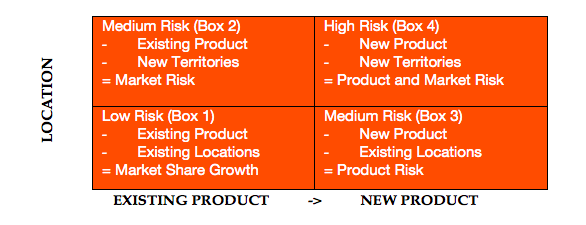Last week I had an interesting discussion with one of my consultancy clients. He’s a terrific guy, highly entrepreneurial, and very successful. Like a lot of entrepreneurs he has lots of big ideas. He was discussing his latest one when I pulled him up and said, “stop!”
You see, the business has a few challenges at present. A couple of the Franchisees are grizzling and one of his Master Franchisees in Asia is insolvent, and he is in the process of taking a party to court for failing to meet their obligations to the Company.
And now he wants to introduce a new concept to a business infrastructure that is not coping with the load it is already carrying.
This is what I said to him.
There are three components to the operation of most businesses.
- Firstly there is the your core business. This is the stuff that you do every day that provides regular and consistent revenue flow. Start-ups crave this type of business, but established businesses already have it. Ideally, once your business gets some stability and scale, your core business operates without being overly reliant on what you do each day. As a result you can spend chunks of time without having to do much to keep the immediate revenues rolling. It’s sometimes called your “bread and butter” business and it gives the business owner time and space to work on new ideas and growth initiatives.
- Then there’s the growth business. Growth can come from the engagement of new customers or the expansion into new territories. Alternatively, we might do new things for, or sell a different product to, an existing customer. Growth business will often start off small with low value and irregular income, which gradually builds if you do a good job. Ideally, your efforts in terms of growth business will enable you to turn that business – those new customers, new markets or new products – into regular revenue that develops into more core business over time.
- Finally, there’s what I call the “big hits” or “opportunistic” This comes along every now and then and allows us to do a big deal or add substantial revenue as a result of a single transaction or event. These opportunities usually arise because your core business activity is positioning you in the right place at the right time.
In most businesses I see, there are opportunities in all three areas. However, the people running these businesses do not see them in the priority I’ve outlined above and therefore tend to be more reactive to the opportunities as they see them, irrespective of what’s going on around them.
In my experience, the key to successfully building a business over time is having an awareness of what constitutes core, growth and opportunistic business and understanding the role that each plays in sustainably growing your empire.
Core Business
Central to this approach is the Core business. The day to day. This is the stuff that just happens, month in, month out, with a steady stream of revenues to match. This is the business that pays the bills. The ideal situation is to have this part of your business running so well that you don’t have spend all of your time on it. That allows you to spend time on the growth opportunities and ‘big hits’.
In order to get to this point it is important to get your core business running properly. Quality of products or services supplied, with minimum returns or rework is critical. Every time you have to come back and do something again, risks the stability and reliability of the core business. Contracts should be professionally completed and understood by all parties up front to minimize subsequent arguments or disruption. Employment agreements should be clear and concise and client expectations transparent and understood. Systems and processes should be ‘people proof’. In other words, to the fullest extent possible, all of the things that can lead to disruption or risk need to be operating so well that the risk is minimised.
So, we need to have all of our stakeholders aligned on what we are trying to achieve, we need the right people in the right place performing the right tasks to the best of their ability and we need our customers to be getting products and services at the level, quality and time that they expect.
Growth Business
We can then focus on the growth opportunities. Growth comes in a number of ways, but is usually one of the following:
- we take our existing activities to additional customers in the same market;
- we take our existing activities to new geographic areas, with both existing and new customers;
- we provide new products or services to existing customers;
- we provide new products or services to new customers.
Of these, item 4) is the most risky. The best advice I ever received was from a very wealthy businessman who had just lost a colossal mount of money in a Telecommunications venture in India. He said that his biggest mistake was that he didn’t fully understand telecommunications and he didn’t understand India. He went on, “if I wanted to do telecommunications, I should have done that in my home country of Canada; and if I wanted to go to India, I should have done so with Real Estate development, the business I understood.”
The great thing about growing your market share or your geographical market presence (ie. selling the same products and services to more customers in existing or new territories – boxes 1 and 2 above), is that executed properly, those customers can quickly become core business.
Opportunistic Business
Of course the big hits only come every now and then and seldom happen without a lot of work. But they happen even less if you are spending all your time on under-performing or stress ridden core business. Your reputation and client satisfaction is key to getting the big opportunities and chances are that the big one-off opportunities will probably involve an existing customer or supplier or both.
For example, you might own a lawn mowing and gardening business. The “big hit” opportunity comes when your existing client wants their entire property to be re-landscaped. Or you might be selling wine, and a supplier calls you with a cancelled export order, meaning that you can buy good quality product at half price.
These opportunities only arise if you are doing a good job of your core business, and as a result your customers or suppliers are happy to create the opportunities for you.
So let’s come back to my client, the highly entrepreneurial, some would say mercurial, character searching for the next step without having the last steps locked into place. We had a discussion along the lines documented above. He saw my point and we have used the conversation as a starter to get some of his core issues sorted out. It’s really difficult stopping the entrepreneur from doing what comes naturally, and what after all, has put them into the position they now are. However, he or she will have a better business in 12 months time as a result.


Recent Comments